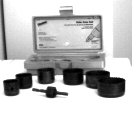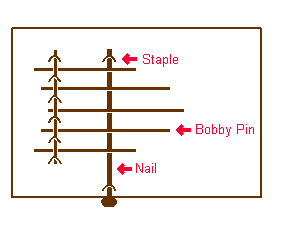Homemade Instruments
Why spend thousands of dollars on expensive musical instruments when you can make your own? Instructions are provided here for just a few of the many possibilities that are available. While all of the following instruments may be made with a minimal amount of effort and a shoestring budget, their construction does require adult supervision as many require the use of sharp objects (hammers, needles, staples, etc.). Happy music making!
Index to the Instruments
- "The Chicken"
- Double Reed Straw
- Hole Saw
- Kalimba
- PVC Pipe Bass Bars
- Rainmaker
"The Chicken"
 The "Chicken" - makes you want to sing along! This lovely instrument sounds like (yeah, you guessed it), a chicken! Hmmm. . . The "Chicken" - makes you want to sing along! This lovely instrument sounds like (yeah, you guessed it), a chicken! Hmmm. . .
Materials:
- Plastic drinking cup
- Small piece of sponge
- Three or four foot piece of cotton crochet thread
Procedure:
- Poke two holes in the bottom of the plastic cup with an embroidery needle.
- Run both ends of thread through the bottom of the cup so that each end hangs out through the top (when held upside down).
- Tie a double half hitch knot on thread and pull tight so that only one end now hangs out of cup.
- Thread loose end of string through small piece of sponge and tie.
- Decorate cup as desired using felt, "google eyes", sharpie pens, etc.
- When complete, moisten sponge, wrap around string near the top, and pull/jerk down to produce "cluck".
"Double Reed Straw"

Materials:
Procedure:
- Clip ends off of end of straw on dotted lines. (see illustration)
- Crease side of straw at the cut end. Cut several tone holes near the bottom of the straw. (Away from the cut end.)
- Place straw in mouth and blow (with a good embouchure, of course)!
"Hole Saw"

Materials:
- Hole Saw set (from the garage or the hardware store) -- should include a drill bit. The set used for this demonstration was made by The Disston Company. It was originally purchased, from a clearance table at a hardware store, to drill a hole in a door.
Procedure:
- Take each drill out of the box and place on a soft surface (carpet scrap).
- Strike each drill with the drill bit and savor the moment!
"Kalimba" (Thumb Piano)

Materials:
- Wood block (approx. 3 " X 4 ")
- Nail (16D 3 " V.C. Sinkers)
- Large bobby pins
- double point staples (9/16)
Procedure:
- Approximately 1/4 of the way down from the top of the block, hammer six double point staples into the wood block 1/2" apart. This will produce a "tunnel" of double point staples.
- Break three large bobby pins in half by bending them or striking on the fold with a hammer. Insert one of these pieces into the "tunnel" of double point staples. Insert the remaining five pieces underneath this "crossbar". To produce different pitches, vary the lengths of the bobby pins.
- Use masking tape to hold pins in place while hammering the "tunnel" of double point staples. Continue to hammer until bobby pins are secure.
- Slide the nail under the five bobby pins. Permanently attach this nail with the two remaining double point staples.
- Enjoy!
"PVC Bass Bars"
Materials:
- 2" PVC drain pipe
- End caps for PVC pipe
Procedure:
- Saw PVC pipe into the following lengths*:
C (low) - 51"
D - 45 "
E - 41"
F - 38"
G - 34"
A - 31"
B - 27"
C (high) - 25"
* Tuning is approximate, you will need to play with these measurements if you wish to be more accurate. Higher octave may be obtained by dividing lengths by 2 and lower octave is created by doubling lengths.
- Place one end cap on each piece of tubing.
- Drop each tube on the ground to play. (Carpet scrap placed on a hard surface, such as slab floor, works best.)
"Rainmaker"

Materials:
- Paper towel or toilet paper tube.
- Box of straight pins
- Masking tape
- Popcorn, beans, small tacks, or ?
Procedure:
- Push straight pins into cardboard tube (use a lot of pins).Close off one end of tube with masking tape.
- Place a small amount of popcorn, or whatever, into tube and experiment with quality of sound before sealing off other end with masking tape.
- Wrap closed tube with masking tape to prevent pins from coming out. (Suggestion: wrap with wood grained contact paper.)
|

